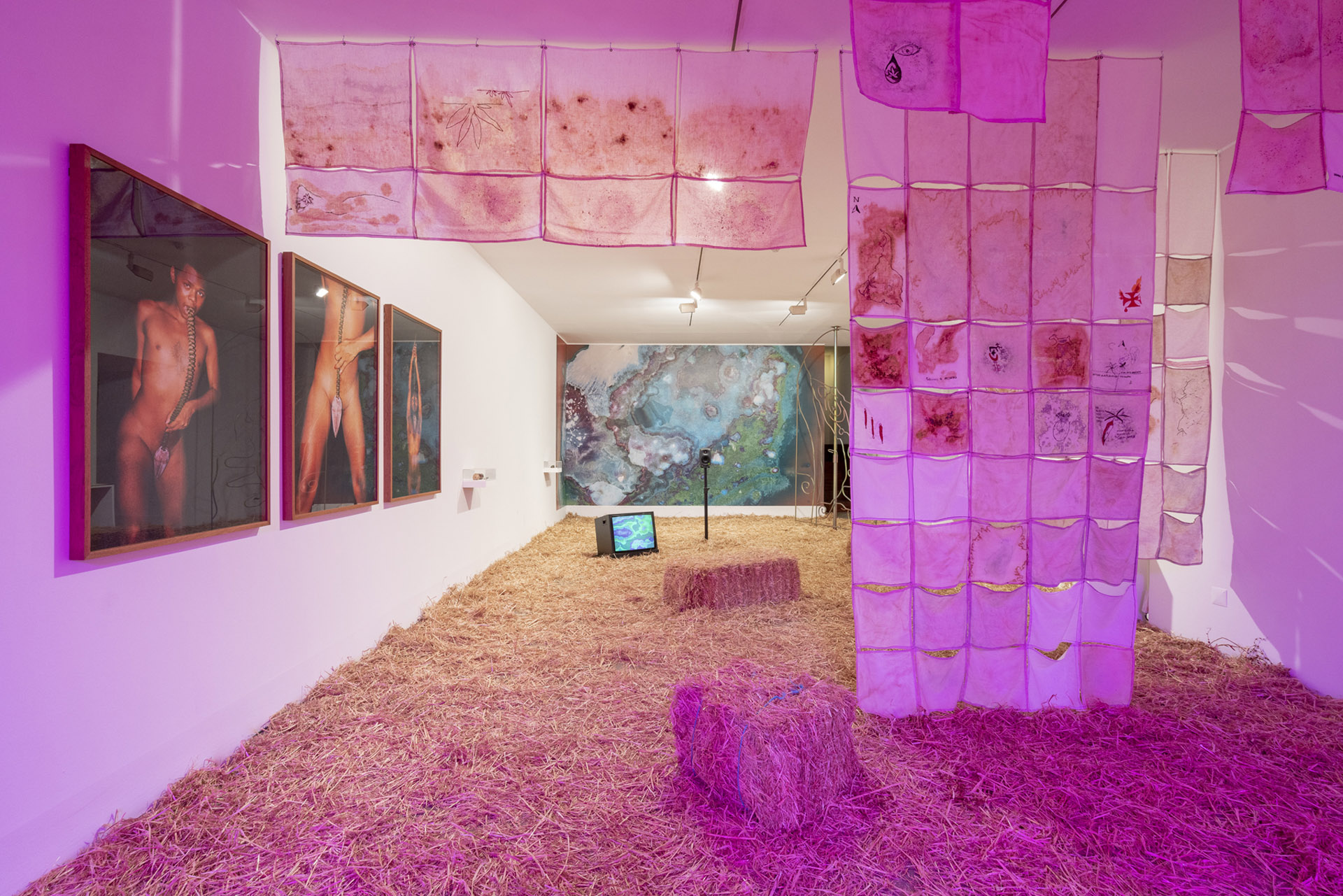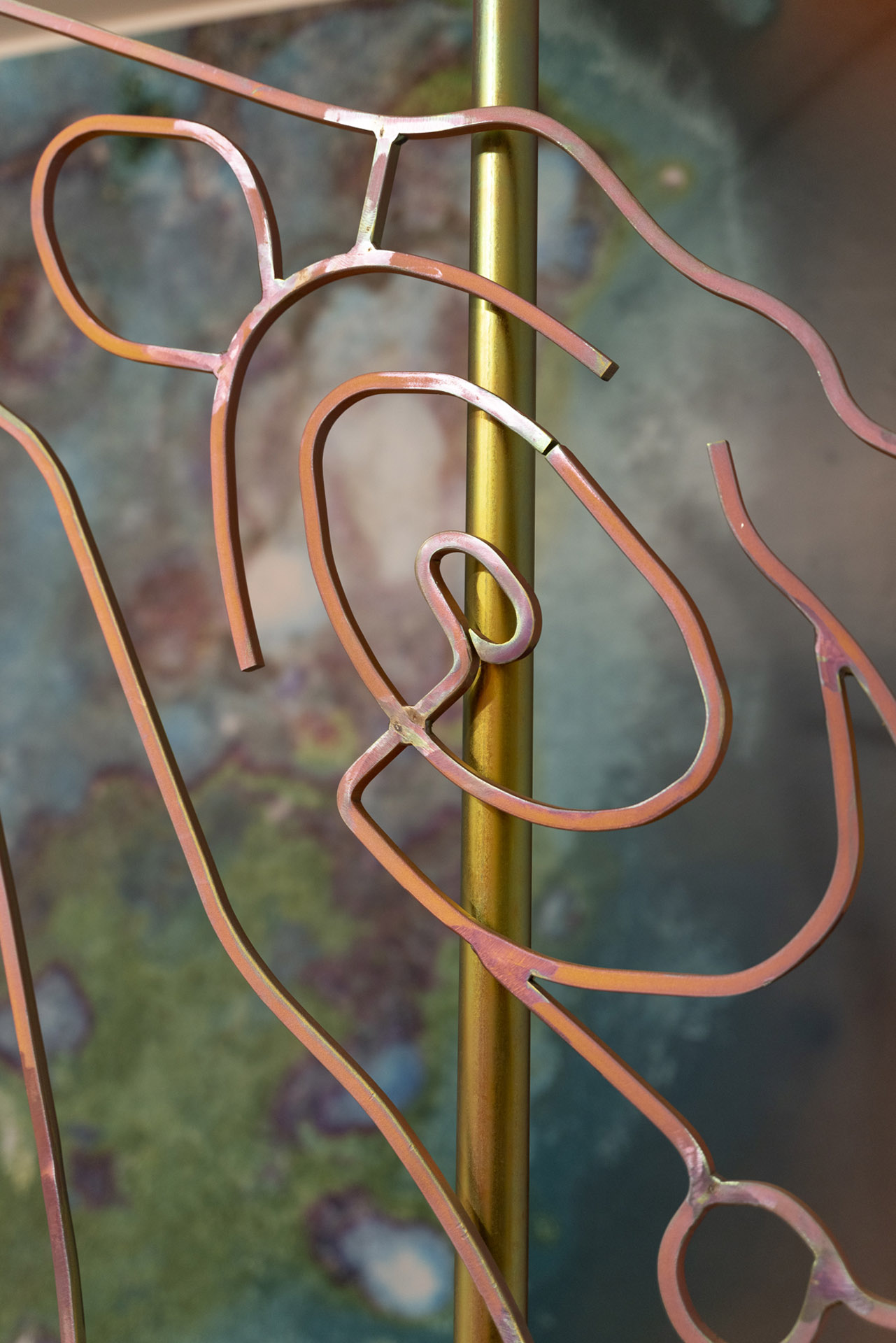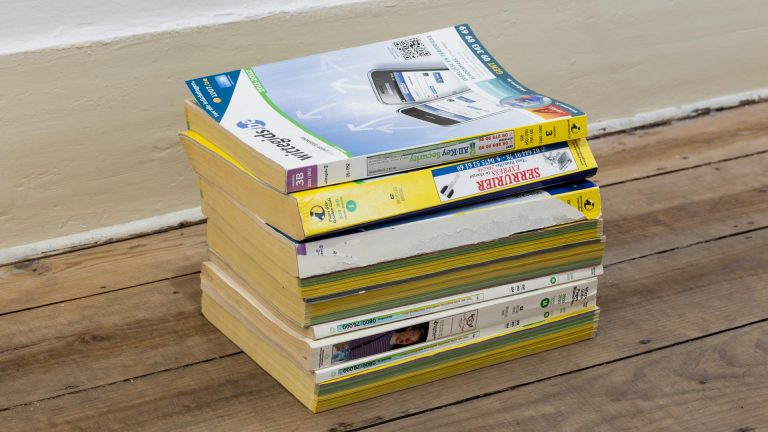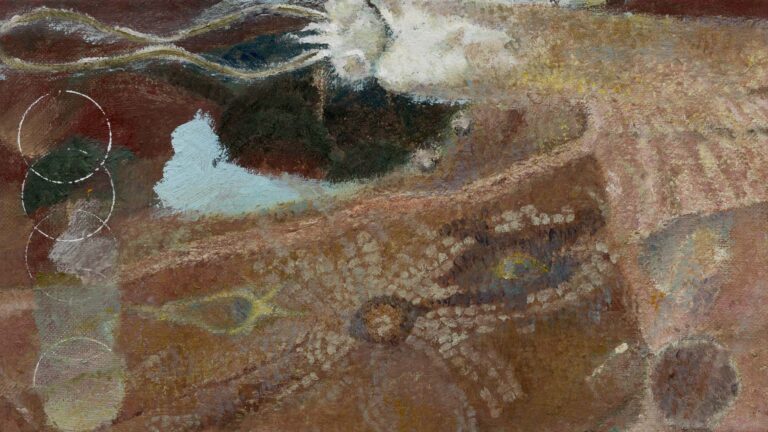Artists: Andreia Santana, Candice Lin, Castiel Vitorino Brasileiro, Cecilia Bengolea, E. M. de Melo e Castro, Sarah Ancelle Schönfeld, Thiago Correia Gonçalves, artefacts from the 17th and 18th centuries (A ring with secret compartment for poisons and a Bezoar Stone, both belonging to the Lisbon Pharmacy Museum), the Xangô Stone (Salvador, Brazil), the Barreto Pharmacy and the Botanical Garden of Lisbon
Exhibition title: Exposição Flamboyanzinho, Flor-de-pavão, Flamboyant-mirim, Barba-de-barata
Curated by: Julia Coelho and Renan Araujo
Venue: Galerias Municipais – Galeria Da Boavista, Lisbon, Portugal
Date: November 6, 2021 – January 30, 2022
Photography: all images copyright and courtesy of the artists and Galerias Municipais – Galeria Da Boavista, Lisbon
Flamboyanzinho, Flor-de-pavão, Flamboyant-mirim, Barba-de-barata, curated by Julia Coelho and Renan Araujo, is a collective exhibition that takes as its starting point the performativity of Caesalpinia pulcherrima given by its toxic and curative properties. Flamboyanzinho, Flor-de-pavão, Flamboyant-mirim, Barba-de-barata are some of the popular names by which Caesalpinia pulcherrima is known in Brazil. While poison brings us closer to death, depending on the dose, it can also work as a cure.
Together with the other works and artefacts gathered in the show, these properties help us reflect on notions of transit, be they oceanic, psychic, metabolic, subterranean, hormonal, poetic or cultural. The exhibition includes pieces from various artists and museum collections and documentation from various sacred places: Andreia Santana, Candice Lin, Castiel Vitorino Brasileiro, Cecilia Bengolea, E. M. de Melo e Castro, Sarah Ancelle Schönfeld, Thiago Correia Gonçalves, artefacts from the 17th and 18th centuries (A ring with secret compartment for poisons and a Bezoar Stone, both belonging to the Lisbon Pharmacy Museum), the Xangô Stone (Salvador, Brazil), the Barreto Pharmacy and the Botanical Garden of Lisbon.
Flamboyanzinho, Flor-de-pavão, Flamboyant-mirim, Barba-de-barata takes as its starting point the performativity of Caesalpinia pulcherrima given by its toxic and curative properties. Like other native species of South and Central America and the Caribbean, the “Flamboyanzinho” was adopted in Europe from the 17th century onwards for its commercial and scientific qualities. On American soil, the “Flor-de-pavão” formed part of a network of exchange between African and indigenous women, who, as one of the strategies of resistance to the colonial slave regime, used the toxicity of the plant’s seeds to perform abortions. When it crossed the ocean, the “Flamboyant-mirim” became part of another network, dissociated from its history of alliances in insurgency movements, and considered a flower of high economic value due to the beauty of its flamboyant colours and forms. The toxic, curative, and performative properties of the “Barba-de-barata”, like those of other migrant plant species, played an important role in the political and social dynamics of the colonial period. Together with the other works and artefacts gathered in this exhibition, these properties now help us reflect on notions of transit, be they oceanic, psychic, metabolic, subterranean, hormonal, poetic or cultural.
If, on the one hand, we can link toxic substances to strategies of maintaining life through death, we can also understand such substances through the prism of their regenerative power in healing and rituals, whether to provide pleasure and nutrition to the body, or to facilitate contact with the divine. Methods for handling such poisonous substances can be preserved for centuries in the form of recipes, songs, and sayings. Intergenerational transmission of such knowledge is not limited to the organs of speech and hearing, but encompasses the totality of the body, which carries ancestral memories of pleasure and pain. These memories, which may also be understood as a space for the preservation of knowledge, as a living archive, are transformed as they are socialised, potentially resulting in therapeutic processes and of production of meanings.
Within the exhibition, these alkaloids derived from poisonous plants serve as guides and stimulate us to consider the conditions that have kept living beings, facts and objects invisible in certain social contexts: a ring with a secret compartment for poisons that was worn by an Italian nobleman, and forms of illegal gambling introduced in the Caribbean by working class Cuban-Chinese migrants. As they can only be experienced by humans through ingestion, these alkaloids react in the dark and highly complex environment inside us. The exterior-interior transit of ingestion is inverted in the case of the Bezoar Stone, a mineral compound formed in the stomach and urinary tracts of ruminant animals and used in Europe from the Middle Ages as an antidote against all poisons, and carried in many rings, bracelets, and necklaces as a magical and precious amulet. Similar patterns of exchange structure the history of the Xangô Stone, a sacred Afro-Brazilian natural monument located in the city of Salvador in the state of Bahia, Brazil. The stone served as an escape route for enslaved people crossing its underwater passage, allowing them to access a realm beyond the reach of manorial power.
Oceanic crossings enabled cultural appropriations and exchanges in which the action and meaning of migrant substances were given new contexts, variously contributing to the construction of diasporic cultures, or generating wealth for dominant groups. The exhibition is continued in two other spaces which embody systems of thinking and operating that were enhanced by the extractivist colonial system: The Botanical Garden and the Pharmacy. From the specific context of the city of Lisbon, these two sites allow us to reflect on the issues raised at Galeria Boavista that relate to the processes of circulation, ritualisation, transformation, commercialisation and institutionalisation of objects and knowledge related to the natural world.
Installation view, Flamboyanzinho, Flor-de-pavão, Flamboyant-mirim, Barba-de-barata, Galeria da Boavista, 2021. © João Paulo Serafim
Caesalpinia pulcherrima, Photograph mouted on backlight, University of Lisbon / Museum of Natural History and Science. © João Paulo Serafim
Installation view, Flamboyanzinho, Flor-de-pavão, Flamboyant-mirim, Barba-de-barata, Galeria da Boavista, 2021. © João Paulo Serafim
Andreia Santana, Mist, 2020, 275 x 175 cm, Iron and extensor with galvanized coating, Courtesy of the artist and Galeria Filomena Soares, Lisbon. © João Paulo Serafim
Pedra de Xangô, Images of the “Caminhada da Pedra de Xangô” walk and newspaper articles documenting the process of listing the Afro-Brazilian sacred natural monument located in the city of Salvador-Bahia, Brazil. © João Paulo Serafim
Bezoar Stone, Germany (?), 18th century, Limestone formed in the stomach and urinary tract of ruminants, such as antelopes, camels, deer and goats, Courtesy of the Health and Pharmacy Museum Collection, Lisbon. © João Paulo Serafim
Luxury ring, Italy (?), 17th century, Brass, iron and enamel paint features a secret compartment to contain poison and antidotes, Courtesy of the Health and Pharmacy Museum Collection, Lisbon. © João Paulo Serafim
Installation view, Flamboyanzinho, Flor-de-pavão, Flamboyant-mirim, Barba-de-barata, Galeria da Boavista, 2021. © João Paulo Serafim
Castiel Vitorino Brasileiro, Gastrite, 2019, 120 x 80 cm (each), Photo prints on cotton paper, Courtesy of the artist. © João Paulo Serafim
Installation view, Flamboyanzinho, Flor-de-pavão, Flamboyant-mirim, Barba-de-barata, Galeria da Boavista, 2021. © João Paulo Serafim
Candice Lin, La Charada China, 2018, Earth, clay, cement, guano, seeds of various plants, grow lights, reflective mylar, straw, lime, video, glass jars, Courtesy of the artist and François Ghebaly, Los Angeles / New York. © João Paulo Serafim
Candice Lin, La Charada China [Detail], 2018, Earth, clay, cement, guano, seeds of various plants, grow lights, reflective mylar, straw, lime, video, glass jars, Courtesy of the artist and François Ghebaly, Los Angeles / New York. © João Paulo Serafim
Candice Lin, La Charada China [[Detail], 2018, Earth, clay, cement, guano, seeds of various plants, grow lights, reflective mylar, straw, lime, video, glass jars, Courtesy of the artist and François Ghebaly, Los Angeles / New York. © João Paulo Serafim
Cecilia Bengolea, Lightning dance, 2018, 6’03’’, Video, sound, Courtesy of the artist and Àngels Gallery, Barcelona. © João Paulo Serafim
Sarah Ancelle Schönfeld, All You Can Feel/ Planets, Opium, 2013,69,5 x 69,5 cm, Liquid Opium on photo negative, enlarged as C-Print, Work displayed in the window of Farmácia Barreto, Rua do Loreto, 24-30, Courtesy of the artist. © João Paulo Serafim





















